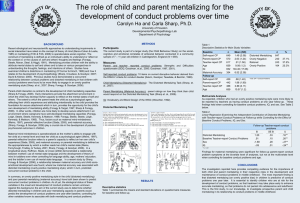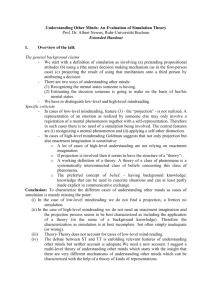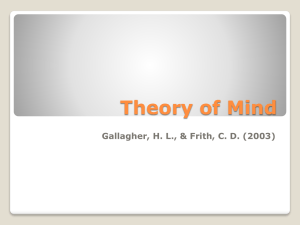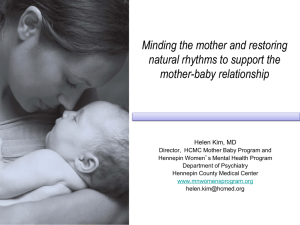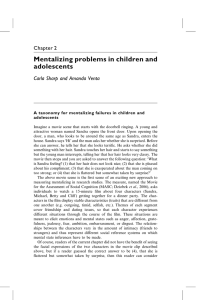The Biological Basis of Social Interaction
advertisement
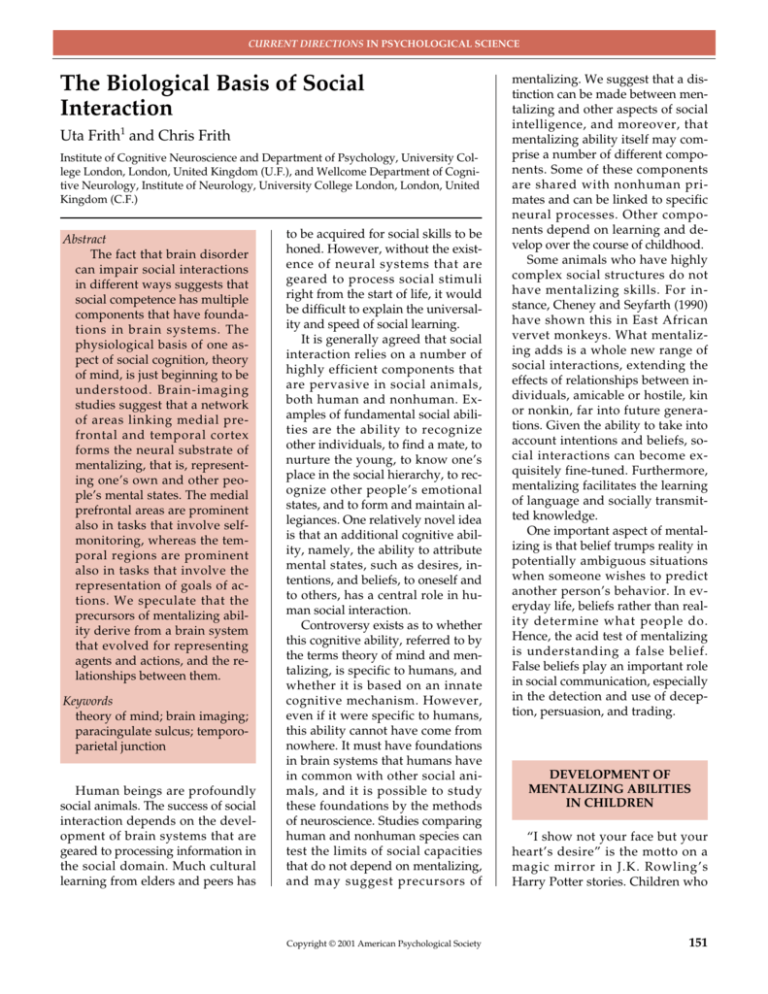
CURRENT DIRECTIONS IN PSYCHOLOGICAL SCIENCE The Biological Basis of Social Interaction Uta Frith1 and Chris Frith Institute of Cognitive Neuroscience and Department of Psychology, University College London, London, United Kingdom (U.F.), and Wellcome Department of Cognitive Neurology, Institute of Neurology, University College London, London, United Kingdom (C.F.) Abstract The fact that brain disorder can impair social interactions in different ways suggests that social competence has multiple components that have foundations in brain systems. The physiological basis of one aspect of social cognition, theory of mind, is just beginning to be understood. Brain-imaging studies suggest that a network of areas linking medial prefrontal and temporal cortex forms the neural substrate of mentalizing, that is, representing one’s own and other people’s mental states. The medial prefrontal areas are prominent also in tasks that involve selfmonitoring, whereas the temporal regions are prominent also in tasks that involve the representation of goals of actions. We speculate that the precursors of mentalizing ability derive from a brain system that evolved for representing agents and actions, and the relationships between them. Keywords theory of mind; brain imaging; paracingulate sulcus; temporoparietal junction Human beings are profoundly social animals. The success of social interaction depends on the development of brain systems that are geared to processing information in the social domain. Much cultural learning from elders and peers has to be acquired for social skills to be honed. However, without the existence of neural systems that are geared to process social stimuli right from the start of life, it would be difficult to explain the universality and speed of social learning. It is generally agreed that social interaction relies on a number of highly efficient components that are pervasive in social animals, both human and nonhuman. Examples of fundamental social abilities are the ability to recognize other individuals, to find a mate, to nurture the young, to know one’s place in the social hierarchy, to recognize other people’s emotional states, and to form and maintain allegiances. One relatively novel idea is that an additional cognitive ability, namely, the ability to attribute mental states, such as desires, intentions, and beliefs, to oneself and to others, has a central role in human social interaction. Controversy exists as to whether this cognitive ability, referred to by the terms theory of mind and mentalizing, is specific to humans, and whether it is based on an innate cognitive mechanism. However, even if it were specific to humans, this ability cannot have come from nowhere. It must have foundations in brain systems that humans have in common with other social animals, and it is possible to study these foundations by the methods of neuroscience. Studies comparing human and nonhuman species can test the limits of social capacities that do not depend on mentalizing, and may suggest precursors of Copyright © 2001 American Psychological Society mentalizing. We suggest that a distinction can be made between mentalizing and other aspects of social intelligence, and moreover, that mentalizing ability itself may comprise a number of different components. Some of these components are shared with nonhuman primates and can be linked to specific neural processes. Other components depend on learning and develop over the course of childhood. Some animals who have highly complex social structures do not have mentalizing skills. For instance, Cheney and Seyfarth (1990) have shown this in East African vervet monkeys. What mentalizing adds is a whole new range of social interactions, extending the effects of relationships between individuals, amicable or hostile, kin or nonkin, far into future generations. Given the ability to take into account intentions and beliefs, social interactions can become exquisitely fine-tuned. Furthermore, mentalizing facilitates the learning of language and socially transmitted knowledge. One important aspect of mentalizing is that belief trumps reality in potentially ambiguous situations when someone wishes to predict another person’s behavior. In everyday life, beliefs rather than reality determine what people do. Hence, the acid test of mentalizing is understanding a false belief. False beliefs play an important role in social communication, especially in the detection and use of deception, persuasion, and trading. DEVELOPMENT OF MENTALIZING ABILITIES IN CHILDREN “I show not your face but your heart’s desire” is the motto on a magic mirror in J.K. Rowling’s Harry Potter stories. Children who 151 152 VOLUME 10, NUMBER 5, OCTOBER 2001 read these stories will take the knowledge of a person’s identity for granted, but the discovery of that person’s inner intentions as something different and, moreover, a highly prized achievement. How do children come to this appreciation? How does an innate predisposition interact with teaching and learning in the unfolding of the ability to mind-read? The development of the ability to attribute mental states in increasingly explicit form has been studied by ingenious paradigms. Laboratory tasks have demonstrated that 4-year-olds understand false beliefs. However, this does not imply an absence of mentalizing capacity in earlier years. Joint attention, considered an early sign of mentalizing, is observable in infants less than a year old: Their gaze follows automatically the gaze of another person and attends to the same visual goal (i.e., object or person). Children between 12 and 18 months old are able to imitate in the strict sense of the term (Meltzoff, 1995). That is, they capture the intention of the individual they are imitating and discriminate intentional and accidental actions. At around the same time, infants show evidence of understanding pretense, an ability that requires the representation of what an agent thinks, feels, or believes about an event (Leslie, 1987). The development of mentalizing in normal children, all over the world, appears to show a steep and rapid rise over the first 5 years of life. This learning is unlikely to start from nothing. It may be that the neural networks that underpin information processing in the social domain are already present in the newborn and rapidly grow through the species-typical social stimulation of infants. A fast track for the development of mentalizing has general benefits. For instance, one early sign of mentalizing, namely, the automatic orienting toward what other people look at, what they say, and what they show, is a general facilitator for learning all kinds of socially transmitted knowledge. WHEN MENTALIZING FAILS Autistic children have characteristic impairments of social interaction and communication, and they lack the spontaneous capacity to understand pretense. They show diminished evidence of joint attention and have grave difficulties understanding false beliefs (see Baron-Cohen, Tager-Flusberg, & Cohen, 2000). Autism thus provides a paradigm to study the consequences of impairment in mentalizing for social interaction. Unlike normally developing children, autistic children lack orientation to other people’s focus of attention, do not show things to others, and do not spontaneously engage in pretend play. As they get older, many such children are unable to apprehend social situations in which mentalizing is the key. Those few who do acquire the ability to understand false beliefs, often as late as their teenage or adult years, appear to achieve this by using complex inferences, which are liable to tell-tale errors—a far cry from the effortless process of normal mentalizing. For example, if someone tells an untruth and everyone laughs, they might infer that the person has told a joke. The long-term consequences of deficits in mentalizing manifest themselves in a lack of social insight that is associated with literal understanding of phrases commonly used for effect rather than truth (e.g., “she is crying her eyes out”), an oftenendearing social naiveté, and an inability to form reciprocal relationships. Intriguingly, autism also provides a glimpse of those social interactions that need not depend on, and have not been superseded Published by Blackwell Publishers Inc. by, mentalizing, for instance, the ability to form attachments, and a liking for company. On theoretical grounds, the system that computes mental states appears to be separable from other cognitive systems. Empirical findings also indicate that the brain basis for mentalizing is dedicated to this function, as deficits in mentalizing are found only in certain neurocognitive disorders, and not in others. Unfortunately, behavioral studies of autistic individuals as well as brain-damaged patients who show mentalizing deficits have not yet demonstrated the precise anatomical location of the neural substrate for mentalizing. However, the techniques of brain imaging appear to be well suited to this purpose. THE BRAIN BASIS OF MENTALIZING There are an increasing number of brain-imaging studies in which volunteers have been asked to perform simple tasks that require taking into account others’ mental states. These tasks have included judging someone else’s knowledge, working out a person’s emotional state when looking at his or her eyes, and understanding the intentions of protagonists in verbal stories, visual cartoons, picture sequences, and animations. All these studies have shown similar regions of the brain to be more active when volunteers make inferences about mental states than when they make inferences about physical or behavioral states. Medial Prefrontal Cortex The most consistently found activation in the studies to date is in the middle of the front of the brain, in a region known as the anterior paracingulate sulcus. This forms the most anterior part of the ante- CURRENT DIRECTIONS IN PSYCHOLOGICAL SCIENCE rior cingulate cortex (ACC), a large C-shaped structure. The same area has been found to be active when people monitor their own mental states. This similarity suggests that attribution of mental states to self and to others depends on the same neuro-cognitive mechanism. The mental states these studies have investigated have included pain, emotions aroused by pictures, thoughts that are not linked to stimuli in the immediate environment, and sensations of ticklishness. Part of ACC is active during observation of freely moving agents. Figure 1 shows the locations of peak activation in this region in a sample of studies involving mentalizing, self-monitoring, and perception of agents. What is known about the function of medial frontal regions from previous studies? Reviews by Bush, Luu, and Posner (2000) and by Paus, Koski, Caramanos, and Westbury (1998) suggest that the ACC can be roughly divided into three regions on the basis of functional imaging studies. The most posterior portion is activated by fairly simple motor tasks. Anterior 153 to this is a region that is activated by complex attention and decision tasks. The most anterior and inferior region is activated by tasks that have an emotional content. Most of the attentional tasks used in these studies required subjects to monitor the response they were making, in other words, to think about their own actions. The areas of activation associated with mentalizing lie between the emotional and motor regions and overlap with the attentional regions of the anterior cingulate (see Fig. 1). Studies in monkeys have shown that neurons in a region corresponding to the upper part of the ACC in humans are active prior to the production of self-initiated movements. Such cells might be involved in representations of the self’s goals. We speculate that the anterior region of the ACC might provide the neural substrate of what is a precursor of mentalizing in that it provides a basis for self-monitoring of actions. Temporo-Parietal Junction Fig. 1. Location of peak activations in medial frontal regions during tasks in which subjects think about their own or other people’s mental states or have to interpret actions of freely moving agents. This schematic illustration shows the inner surface of the right hemisphere of the brain. For references to the tasks that resulted in heightened activations in the areas indicated, see Frith and Frith (2000). The location of the motor region of the anterior cingulate is based on Paus, Koski, Caramanos, and Westbury (1998). The location of the attentional and emotional regions is based on Bush, Luu, and Posner (2000). The numbers on the axes refer to the distance in millimeters from a standard origin in the center of the brain (the anterior commisure). Copyright © 2001 American Psychological Society The other brain region that has been shown to be most consistently activated in mentalizing tasks is the temporo-parietal junction (TPJ). As Figure 2 shows, the peak activations at the TPJ during mentalizing are at the back and top of the superior temporal sulcus (STS). This region is at the very top of the temporal cortex, situated above the ears. Part of STS is also active during observation of biological motion (e.g., of the hands or mouth). However, the area known as V5/MT, which is responsible for the perception of pure motion, is in a different place, as indicated in Figure 2. Studies in animals suggest that neurons in STS provide the basis for the representation of agents who move of their own accord (for a recent review, see Allison, Puce, & McCarthy, 2000). Furthermore, as Gallese and Goldman (1998) observed, the ability of both human 154 VOLUME 10, NUMBER 5, OCTOBER 2001 Fig. 2. Location of peak activations in the right temporo-parietal junction during tasks in which subjects think about other people’s mental states or in which biological motion is presented. This schematic illustration shows the outer surface of the right hemisphere of the brain. For references to the tasks that resulted in heightened activations in the areas indicated, see Frith and Frith (2000). For comparison purposes, the illustration shows the location of V5/MT, which is activated during perception of pure motion. The numbers on the axes refer to the distance in millimeters from a standard origin in the center of the brain (the anterior commisure). and nonhuman primates to detect goals in the observed behavior of conspecifics is a likely precursor of mentalizing ability. Activity in mirror neurons in this region seems to relate to specific actions (or goals), whether these are being performed by the self or another. Such neurons could provide the basis for abstract representations of goals. Mirror neurons are so called because they are active both when a monkey observes someone else grasping an object in a particular way and when the monkey itself grasps the object in the same way. Of course, for mentalizing to be successful, it is not enough to represent action-goal states; the ability to distinguish between actions of the self and of others is a critical re- quirement for effective social interaction. Cells that are activated by sights and sounds generated by others, but not by the same stimuli when these are self-generated, have also been found in STS. Other Possible Components of the Mentalizing System In all the functional imaging studies of mentalizing, additional brain regions have been activated, but much less consistently. One of the more frequently seen activations is in the tips of the temporal lobes (the temporal poles, thought to be involved in multimodal representations of objects and events) and the adjacent almond-shaped Published by Blackwell Publishers Inc. structure known as the amygdala (thought to be involved in emotional learning). Different types of learning are mediated by amygdala subsystems, which are well connected to other brain regions (see Holland & Gallagher, 1999). It is easy to see that emotional learning could play a crucial role in social interaction, in which the goals of different agents have to be monitored and evaluated. Furthermore, studies have shown that the amygdala may play a role in detecting where another person’s gaze is directed. This ability could well be linked to joint attention, a capacity that predates the development of other mind-reading accomplishments in young children. To be able to follow another person’s gaze and to distinguish where another person is directing his or her attention could act as important cues to trigger the development of mentalizing. Nevertheless, it is questionable whether these abilities are necessary, because blind children can be competent mentalizers. Brothers (1997) suggested that the amygdala and orbito-frontal cortex (situated at the bottom of the frontal lobes just above the eyes and involved in the representation of reward and punishment) form part of a social editor that underpins mentalizing as well as other kinds of social interactions. However, orbitofrontal cortex is conspicuous by its lack of activation in brain-imaging studies of mentalizing. The role of this region and of other components of the limbic system (the system traditionally associated with arousal and emotion processing) in a variety of social interactions is not in doubt. However, it would be important to know to what extent these components are sufficient or necessary for the ability to mentalize. It needs to be remembered that social interactions that do not involve mentalizing remain important in humans. Thus, impairments in mentalizing, as found in autism, do not abolish CURRENT DIRECTIONS IN PSYCHOLOGICAL SCIENCE social competence wholesale. Instead, such impairments may coexist with other social accomplishments. HOW DID THE MENTALIZING SYSTEM EVOLVE? What might be the precursors of mentalizing in other species? The TPJ is likely to play an important role. This area, which is at the very top and at the very back of STS, is consistently and strongly activated in brain-imaging studies of mentalizing, predominantly but not exclusively on the right. One major information processing system of the brain, the “what” system, runs along the bottom of the brain (ventral stream); the other, the “where” system, runs along the top (dorsal stream). The ventral stream is concerned with the recognition of objects and individuals. The dorsal stream is concerned with the generation of actions. The TPJ is halfway between these streams, and we can speculate that this is an ideal location to act as interface. A basic prerequisite of mentalizing may well be the ability to link objects (ventral stream) and actions (dorsal stream), enabling people to recognize objects and individuals in terms of the appropriateness of actions and to recognize intentions in terms of their appropriateness toward objects. If our analysis of the precursor functions is correct, then the human ability to mentalize seems to have evolved largely from the dorsal action system, which includes ACC, rather than the ventral object-identification system, which includes basal temporal cortex with temporal poles and amygdala. Much of social intelligence, already so well developed in the monkey, can be seen as deriving from the ventral system. It depends on complex and sophisticated recognition of objects and individuals, recognition of subtle differences in emotional expression, and recognition of the status of other individuals. Mentalizing, in contrast, required the development of capabilities relating to the representation of actions, the goals implicit in actions, and the intentions behind them. In short, the main requirement for a mentalizing system is the ability to represent the relationship between agents and their actions. Recommended Reading Baron-Cohen, S. (1995). Mindblindness: An essay on autism and theory of mind . Cambridge, MA: MIT Press. Frith, C.D., & Frith, U. (2000). Interacting minds–A biological basis. Science, 286, 1692–1695. Scholl, B.J., & Leslie, A.M. (1999). Modularity, development and “theory of mind.” Mind and Language, 14, 131–153. Copyright © 2001 American Psychological Society 155 Note 1. Address correspondence to Uta Frith, Institute of Cognitive Neuroscience, University College London, 17 Queen Square, WC1N 3AR, London, United Kingdom. References Allison, T., Puce, A., & McCarthy, G. (2000). Social perception from visual cues; role of the STS region. Trends in Cognitive Sciences, 4, 267–278. Baron-Cohen, S., Tager-Flusberg, H., & Cohen, D. (Eds.). (2000). Understanding other minds: Perspective from developmental neuroscience (2nd ed.). Oxford, England: Oxford University Press. Brothers, L. (1997). Friday’s footprint: How society shapes the human mind. Oxford, England: Oxford University Press. Bush, G., Luu, P., & Posner, M.I. (2000). Cognitive and emotional influences in anterior cingulate cortex. Trends in Cognitive Sciences, 4, 215–222. Cheney, D.L., & Seyfarth, R.M. (1990). How monkeys see the world: Inside the mind of another species. Chicago: University of Chicago Press. Frith, C.D., & Frith, U. (2000). The physiological basis of theory of mind. In S. Baron-Cohen, H. Tager-Flusberg, & D. Cohen (Eds.), Understanding other minds: Perspective from developmental neuroscience (pp. 335–356). Oxford, England: Oxford University Press. Gallese, V., & Goldman, A. (1998). Mirror neurons and the simulation theory of mind-reading. Trends in Cognitive Sciences, 2, 493–501. Holland, P.C., & Gallagher, M. (1999). Amygdala circuitry in attentional and representational processes. Trends in Cognitive Sciences, 3, 65–73. Leslie, A.M. (1987). Pretense and representation: The origins of “theory of mind.” Psychological Review, 94, 412–426. Meltzoff, A.N. (1995). Understanding the intentions of others: Re-enactment of intended acts by 18month-old children. Developmental Psychology, 31, 838–850. Paus, T., Koski, L., Caramanos, Z., & Westbury, C. (1998). Regional differences in the effects of task difficulty and motor output on blood flow response in the human anterior cingulate cortex: A review of 107 PET activation studies. NeuroReport, 9, R37–R47.

